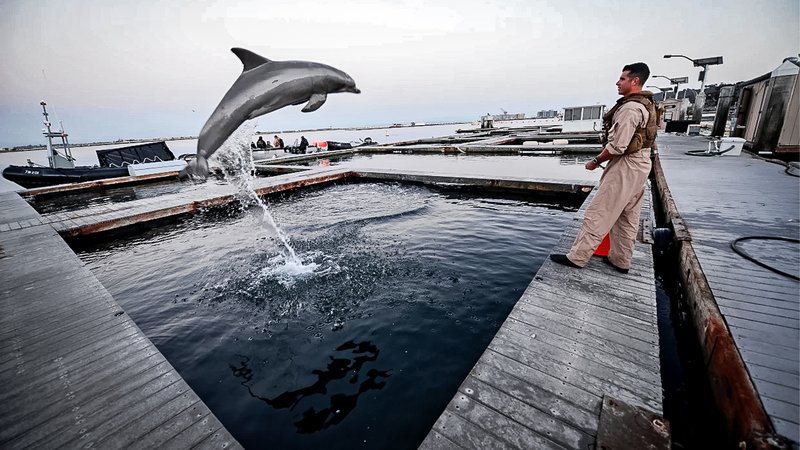
Navy Diver 2nd Class Andres Palacio, left, Navy Diver 2nd Class Michael Gerstel and Quartermaster 2nd Class Kyle Holzl, handlers assigned to Marine Mammal Company of Explosive Ordnance Disposal Mobile Unit (EODMU) 1, work with a bottlenose dolphin at Joint Expeditionary Base Little Creek-Fort Story during Frontier Sentinel 2010. Photo by Mass Communication Specialist 2nd Class Rafael Martie.
In late March 2003, just days after the American-led coalition had commenced its invasion of Iraq, a team of US Navy veterinarians arrived at Umm Qasr — home of Iraq’s only deep-water port — with two bottlenose dolphins. The dolphins, named Tacoma and Makai, had been flown in from California to assist US, British, and Australian military divers with clearing underwater mines from the estuary that connects Umm Qasr to the Persian Gulf.
Initially, divers with the US Navy’s Special Clearance Team-One had searched for the mines by hand. One of the divers told reporters at the time that the job was like “crawling around in the mud with your eyes shut.” Then, after that approach proved too difficult, the team began using sonar-equipped underwater drones. The drones were much more efficient. In less than 24 hours, they identified more than 200 unknown submerged objects. Which presented another challenge: figuring out what all of those objects were.

Hull Technician 2nd Class Christopher Burgess works with a bottlenose dolphin in 2013. Burgess' unit was working with bottlenose dolphins as a means of locating and marking mines on the seafloor, tethered in the water column or in shallow water. Photo by Petty Officer 1st Class Joshua Scott.
For better or worse, dolphins are uniquely suited to the task of mine sweeping. This is because they can differentiate between natural formations and man-made devices using echolocation, or bio sonar, which allows them to discern the contours of an underwater object from a distance via sound waves.
By the time the Navy put flippers in the water in Iraq, its efforts to militarize dolphins had been underway for several decades. In 1959, the Navy Marine Mammal Program (NMMP) was established to determine whether maritime animals could outperform humans and machines in conducting dangerous underwater operations. Ultimately, the scientists and veterinarians involved in the program concluded that one particular species could — the Atlantic bottlenose dolphin, which, they found was not only naturally equipped for the job, but also very trainable.

Gen. Martin E. Dempsey, chairman of the Joint Chiefs of Staff, receives a capabilities brief on the U.S. Navy Marine Mammal Program by sailors assigned to Explosive Ordnance Disposal Mobile Unit 1. The Marine Mammal Program uses bottlenose dolphins operated by EODMU-1 as a means of locating and marking mines that are on the sea floor, tethered in the water column or in shallow water. Photo by Petty Officer 1st Class Joshua Scott.
In Iraq, Tacoma and Makai were soon joined by several more Atlantic bottlenose dolphins, including Jefe and Khalili, both males, and Kona and Punani, both females. In less than a week, the pod helped divers clear a path for a British military ship to reach Umm Qasr without incident and deliver food and medical supplies. But their work was just getting started. According to an article published in James Madison University’s Journal of Conventional Weapons Destruction, within the first several weeks of the war, dolphins conducted “unofficial clearance of 913 nautical miles of water, investigation of 237 objects, and recovery and/or destruction of over 100 mines.”
Today, the NMMP maintains an arsenal of about 120 Atlantic bottlenose dolphins and California sea lions, most of whom reside in floating pens in San Diego, Calif. In addition to mine clearing, the animals are trained to conduct recovery operations and detect foreign waterborne intruders. They are also said to harass Navy SEALs during underwater dive training.
Read Next: Land Mine Detection Rat Receives the Animal Equivalent to the Distinguished Service Cross

Matt Fratus is a history staff writer for Coffee or Die. He prides himself on uncovering the most fascinating tales of history by sharing them through any means of engaging storytelling. He writes for his micro-blog @LateNightHistory on Instagram, where he shares the story behind the image. He is also the host of the Late Night History podcast. When not writing about history, Matt enjoys volunteering for One More Wave and rooting for Boston sports teams.
BRCC and Bad Moon Print Press team up for an exclusive, limited-edition T-shirt design!
BRCC partners with Team Room Design for an exclusive T-shirt release!
Thirty Seconds Out has partnered with BRCC for an exclusive shirt design invoking the God of Winter.
Lucas O'Hara of Grizzly Forge has teamed up with BRCC for a badass, exclusive Shirt Club T-shirt design featuring his most popular knife and tiomahawk.
Coffee or Die sits down with one of the graphic designers behind Black Rifle Coffee's signature look and vibe.
Biden will award the Medal of Honor to a Vietnam War Army helicopter pilot who risked his life to save a reconnaissance team from almost certain death.
Ever wonder how much Jack Mandaville would f*ck sh*t up if he went back in time? The American Revolution didn't even see him coming.
A nearly 200-year-old West Point time capsule that at first appeared to yield little more than dust contains hidden treasure, the US Military Academy said.












